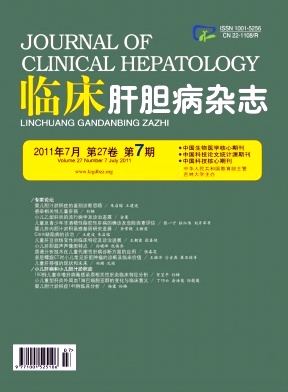|
[1]Moran JR, Gishan FK, Halter SA, et al.Steatohepatitis inobese children:a cause of chronic liver dysfunction[J].Am JGastroenterol, 1983, 78 (6) :374-377.
|
|
[2]Schwimmer BJ, Deutsch R, Kahen T, et al.Prevalence of fattyliver in children and adolescents[J].Pediatrics, 2006, 118 (4) :1388-1393.
|
|
[3]Park HS, Han JH, Choi KM, et al.Relation between elevatedserumalanine aminotransferase and metabolic syndrome in koreanadolescents[J].Am J Clin Nutr, 2005, 82 (5) :1046-1051.
|
|
[4]Cortez-Pinto H, Camilo ME, Baptiste A, et al.Non-alcoholic fattyliver:another feature of metabolic syndrome?[J].Clin Nutr, 1999, 18 (6) :353-358.
|
|
[5]Roberts EA.Nonalcoholic steatohepatitis in children[J].CurrGastroenterol Rep, 2003, 5 (3) :253-259.
|
|
[6]Nobili V, Marcellini M, Devito R, et al.NAFLD in children:aprospective clinical-pathological study and effect of lifestyleadvice[J].Hepatology, 2006, 44 (2) :458-465.
|
|
[7]Yoneda M, Iwasaki T, Fujita K, et al.Hypoadiponectinemia plays acrucial role in the development of nonalcoholic fatty liver diseasein patients with type 2 diabetes mellitus independent of visceraladipose tissue[J].Alcohol Clin Exp Res, 2007, 31 (Suppl 1) :15S-21S.
|
|
[8]Schwimmer JB.Definitive diagnosis and assessment of risk for nonalcoholic fatty liver disease in children and adolescents[J].Semin Liver Dis, 2007, 27 (3) :312-318.
|
|
[9]Kinugasa A, Tsunamoto K, Furukawa N, et al.Fatty liver and itsfibrous changes found in simple obesity of children[J].J PediatrGastroenterol Nutr, 1984, 3 (3) :408-414.
|
|
[10]Baldridge AD, Perez-Atayde AR, Graeme-Cook F, et al.Idiopathicsteatohepatitis in childhood:a multicenter retrospective study[J].JPediatr, 1995, 127 (5) :700-704.
|
|
[11]Schwimmer JB, Deutsch R, Rauch JB, et al.Obesity, insulinresistance, and other clinicopathogical correlations of pediatricnonalcoholic fatty liver disease[J].J Pediatr, 2003, 143 (4) :500-505.
|
|
[12]Chan DFY, Li AM, Chu WC, et al.Hepatic steatosis in obeseChinese children[J].Int J Obes Relat Metab Disord, 2004, 28 (10) :1257-1263.
|
|
[13]Jeffrey B, Schwimmer MD, Perrie E, et al.Cardiovascular riskfactors and the metabolic syndrome in pediatric nonalcoholic fattyliver disease[J].Circulation, 2008, 118:277-283.
|
|
[14]Marion AW, Baker AJ, Dhawan A.Fatty liver disease in children[J].Arch Dis Child, 2004, 89 (7) :648-652.
|
|
[15]Fernandes MT, Ferraro AA, de Azevedo RA, et al.Metabolicdifferences between male and female adolescents with non-alcoholic fatty liver disease, as detected by ultrasound[J].ActaPfidiatrica, 2010, 99 (8) :1218-1223.
|
|
[16]Fishbein MH, Mogree C, Gleason T, et al.Relationship of hepaticsteatosis to adipose tissue distribution in pediatric nonalcoholicfatty liver disease[J].J Pediatr Gastroerrterol Nutr, 2006, 42 (1) :83-88.
|
|
[17]Goran MI, Gower BA.Longitudinal study on pubertal insulinresistance[J].Diabetes, 2001, 50 (11) :2444-2450.
|
|
[18]Papandreou D, Rousso I, Mavromichalis I.Update on non-alcoholic fatty liver disease in children[J].Clin Nutr, 2007, 26 (4) :409-415.
|
|
[19]Schwimmer JB, McGreal N, Deutsch R, et al.Infiuence of gender, race, and ethnicity on suspected fatty liver in obeseadolescents[J].Pediatrics, 2005, 115 (5) :e561-565.
|
|
[20]Clark JM, Brancati FL, Diehl AM, et al.Nonalcoholic fatty liverdisease[J].Gastroenterology, 2002, 122:1649-1657.
|
|
[21]Schwimmer JB, Khorram O, Chiu V, et al.Abnormal aminotransferase activity in women with polycysticovary syndrome[J].FertilSteril, 2005, 83 (2) :494-497.
|
|
[22]Cerda C, Pérez-Ayuso RM, Riquelme A, et al.Nonalcoholic fattyliver disease in women with polycystic ovary syndrome[J].JHepatol, 2007, 47 (3) :412-417.
|
|
[23]Muthusamy T, Dhevika S, Murugesan P, et al.Testosteronedeftciency impairs glucose oxidation through defective insulinand its receptor gene expression in target tissues of'adult malerats[J].Life Sci, 2007, 8 (7) :534-542.
|
|
[24]Fain JN, Madan AK, Hiler ML, et al.Comparison of the release ofadipokines by adipose tissue, adipose tissue matrix, and adipocytesfrom visceral and subcutaneous abdominal adipose tissues of obesehumans[J].Endocrinology, 2004, 145 (5) :273-282.
|
|
[25]Khashab MA, Liangpunsakul S, Chalasani N.Nonalcoholic fattyliver disease as a component of the metabolic syndrome[J].CurtGastroenterol Rep, 2008, 10 (1) :73-80.
|
|
[26] 中华医学会肝脏病学分会脂肪肝和酒精性肝病学组.非酒精性脂肪性肝病诊疗指南 (2010年修订版) [J].中华内科杂志, 2010, 49 (3) :275-278.
|
|
[27]Wang CL, Liang L, Fu JF, et al.Effect of lifestyle intervention onnon-alcoholic fatty liver disease in chinese obese children[J].World J Gastroenterol, 2008, 14 (10) :1598-1602.
|
|
[28]Vajro P, Fontanella A, Perna C, et al.Persistent hyperaminotransferasemia resolving after weight reduction in obesechildren[J].J Pediatr, 1994, 125 (2) :239-241.
|













 DownLoad:
DownLoad: